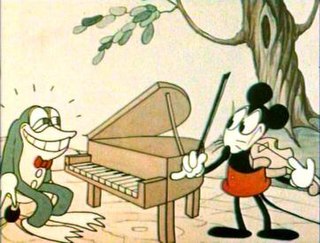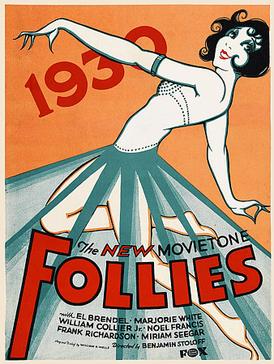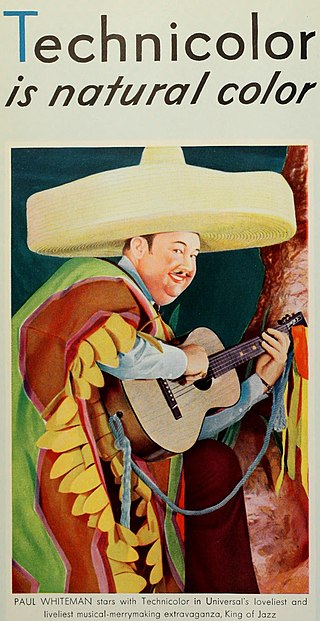The Fox Film Corporation was an American Independent film production studio formed by William Fox (1879–1952) in 1915, by combining his earlier Greater New York Film Rental Company and Box Office Attraction Company.

35 mm film is a film gauge used in filmmaking, and the film standard. In motion pictures that record on film, 35 mm is the most commonly used gauge. The name of the gauge is not a direct measurement, and refers to the nominal width of the 35 mm format photographic film, which consists of strips 1.377 ± 0.001 inches (34.976 ± 0.025 mm) wide. The standard image exposure length on 35 mm for movies is four perforations per frame along both edges, which results in 16 frames per foot of film.

Flip the Frog is an animated cartoon character created by American animator Ub Iwerks. He starred in a series of cartoons produced by Celebrity Pictures and distributed by Metro-Goldwyn-Mayer from 1930 to 1933. The series had many recurring characters besides Flip; including Flip's dog, the mule Orace, and a dizzy neighborhood spinster.

Sound-on-film is a class of sound film processes where the sound accompanying a picture is recorded on photographic film, usually, but not always, the same strip of film carrying the picture. Sound-on-film processes can either record an analog sound track or digital sound track, and may record the signal either optically or magnetically. Earlier technologies were sound-on-disc, meaning the film's soundtrack would be on a separate phonograph record.

Cinecolor was an early subtractive color-model two-color motion picture process that was based upon the Prizma system of the 1910s and 1920s and the Multicolor system of the late 1920s and the 1930s. It was developed by William T. Crispinel and Alan M. Gundelfinger, and its various formats were in use from 1932 to 1955.
Film tinting is the process of adding color to black-and-white film, usually by means of soaking the film in dye and staining the film emulsion. The effect is that all of the light shining through is filtered, so that what would be white light becomes light of some color.

The Great Gabbo is a 1929 American Pre-Code early sound musical drama film directed by James Cruze, based on Ben Hecht's 1928 short story "The Rival Dummy", and starring Erich von Stroheim and Betty Compson. The film features songs by Lynn Cowan, Paul Titsworth, Donald McNamee and King Zany.
In cinematography, bipacking, or a bipack, is the process of loading two reels of film into a camera, so that they both pass through the camera gate together. It was used both for in-camera effects and as an early subtractive colour process.

Color motion picture film refers both to unexposed color photographic film in a format suitable for use in a motion picture camera, and to finished motion picture film, ready for use in a projector, which bears images in color.
Trucolor was a color motion picture process used and owned by the Consolidated Film Industries division of Republic Pictures. It was introduced as a replacement for Consolidated's own Magnacolor process.
Duplitized film was a type of motion picture print film stock used for some two-color natural color processes. It was introduced by Eastman Kodak around 1913. The stock was of standard gauge and thickness, but it had a photographic emulsion coated on both sides of the film base instead of on one surface only.

The Prizma Color system was a color motion picture process, invented in 1913 by William Van Doren Kelley and Charles Raleigh. Initially, it was a two-color additive color system, similar to its predecessor, Kinemacolor. However, Kelley eventually transformed Prizma into a bi-pack color system that itself became the predecessor for future color processes such as Multicolor and Cinecolor.

Madam Satan or Madame Satan is a 1930 American pre-Code musical comedy film in black and white with Multicolor sequences. It was produced and directed by Cecil B. DeMille and starred Kay Johnson, Reginald Denny, Lillian Roth, and Roland Young
In bipack color photography for motion pictures, two strips of black-and-white 35 mm film, running through the camera emulsion to emulsion, are used to record two regions of the color spectrum, for the purpose of ultimately printing the images, in complementary colors, superimposed on one strip of film. The result is a multicolored projection print that reproduces a useful but limited range of color by the subtractive color method. Bipack processes became commercially practical in the early 1910s when Kodak introduced duplitized film print stock, which facilitated making two-color prints.

Fox Movietone Follies of 1929, also known as Movietone Follies of 1929 and The William Fox Movietone Follies of 1929, is an American black-and-white and color pre-Code musical film released by Fox Film Corporation.

New Movietone Follies of 1930 is a 1930 American Pre-Code musical film released by Fox Film Corporation, directed by Benjamin Stoloff. The film stars El Brendel and Marjorie White who also costarred in Fox's Just Imagine in 1930.
Ted Eshbaugh was an American animation filmmaker, best known as one of the first filmmakers to experiment with color sound cartoons in the early 1930s, which included Goofy Goat and The Wizard of Oz.

Technicolor is a series of color motion picture processes, the first version dating back to 1916, and followed by improved versions over several decades.
William Thomas Crespinel was the inventor of a bipack process, which allowed any cinematic camera to shoot color film. In 1932 he developed Cinecolor.











